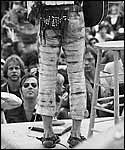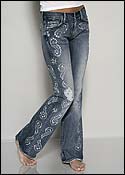
1969 Woodstock
The counterculture co-opts the industrial working man’s wardrobe, taking it back to the garden with embroidery, fringe, tie-dye, and neglect.
1974 Disco jeans
The antithesis of hippie jeans arrives via Europe; they’re made from crisp, immaculate denim with elaborate patchwork and glitzy pocket treatments, and worn excruciatingly tight or bell-bottom style.
1980Rhinestone cowboys
Unlikely lariat-wielders Robert Redford (The Electric Horseman) and John Travolta (Urban Cowboy) take rodeo-jean tropes channel-stitched appliqués, shiny metal studs, homely fabrics—mainstream.
1999Gucci
Thirty years after Yasgur’s farm, Tom Ford sends frayed, embroidered, and feathered jeans down the runway—for $3,500. “Luxe hippie” becomes a trend-report oxymoron.
2001 L.A. rock
Surfer turned designer Henry Duarte picks up the torch for ornate jeans with $475 versions of the low-rise, lace-up, psychedelic-rock-inspired styles he custom-makes for clients like Lenny Kravitz, Sheryl Crow, and Steven Tyler.

2005 New York
With shoppers sated on $200 “basic” jeans, manufacturers reach once again for showier techniques to persuade customers to triple their spend. Here, Seven/Great China Wall’s $995 Swarovski crystal-encrusted jeans.